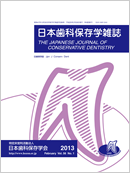Volume 51, Issue 1
Displaying 1-11 of 11 articles from this issue
- |<
- <
- 1
- >
- >|
Original Articles
-
Article type: Original Articles
2008 Volume 51 Issue 1 Pages 1-8
Published: February 29, 2008
Released on J-STAGE: March 31, 2018
Download PDF (1579K) -
Article type: Original Articles
2008 Volume 51 Issue 1 Pages 9-15
Published: February 29, 2008
Released on J-STAGE: March 31, 2018
Download PDF (1024K) -
Article type: Original Articles
2008 Volume 51 Issue 1 Pages 16-23
Published: February 29, 2008
Released on J-STAGE: March 31, 2018
Download PDF (906K) -
Article type: Original Articles
2008 Volume 51 Issue 1 Pages 24-39
Published: February 29, 2008
Released on J-STAGE: March 31, 2018
Download PDF (6512K) -
Article type: Original Articles
2008 Volume 51 Issue 1 Pages 40-47
Published: February 29, 2008
Released on J-STAGE: March 31, 2018
Download PDF (949K) -
Article type: Original Articles
2008 Volume 51 Issue 1 Pages 48-62
Published: February 29, 2008
Released on J-STAGE: March 31, 2018
Download PDF (3286K) -
Article type: Original Articles
2008 Volume 51 Issue 1 Pages 63-71
Published: February 29, 2008
Released on J-STAGE: March 31, 2018
Download PDF (1563K) -
Article type: Original Articles
2008 Volume 51 Issue 1 Pages 72-81
Published: February 29, 2008
Released on J-STAGE: March 31, 2018
Download PDF (1247K) -
Article type: Original Articles
2008 Volume 51 Issue 1 Pages 82-87
Published: February 29, 2008
Released on J-STAGE: March 31, 2018
Download PDF (1668K) -
Article type: Original Articles
2008 Volume 51 Issue 1 Pages 88-98
Published: February 29, 2008
Released on J-STAGE: March 31, 2018
Download PDF (4114K) -
Article type: Original Articles
2008 Volume 51 Issue 1 Pages 99-104
Published: February 29, 2008
Released on J-STAGE: March 31, 2018
Download PDF (875K)
- |<
- <
- 1
- >
- >|
